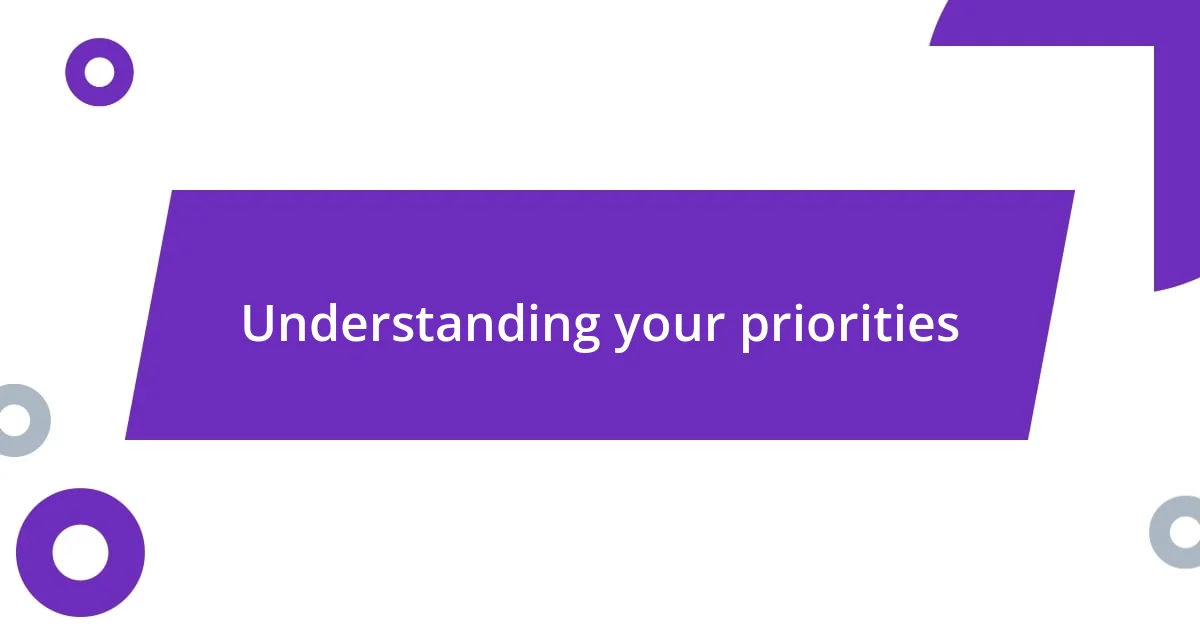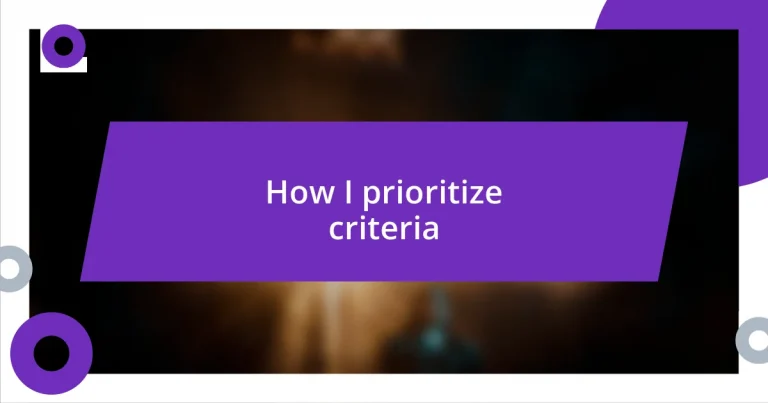Key takeaways:
- Reflect on what truly matters to align priorities with personal values and to avoid living solely by obligations.
- Utilize a decision matrix to visually organize options and criteria, enhancing clarity and confidence in decision-making.
- Regularly review and adjust your criteria to ensure they remain relevant and aligned with evolving personal and professional goals.

Understanding your priorities
Understanding your priorities starts with a deep dive into what truly matters to you. I remember a time when I felt overwhelmed by tasks at work, constantly chasing deadlines. It took a moment of reflection to realize that I was prioritizing urgent tasks over meaningful ones—tasks that aligned with my personal and professional growth. Have you ever found yourself caught in that same loop?
Another crucial aspect of recognizing your priorities is examining your values. I once had a friend who juggled multiple commitments but ultimately found herself drained and unfulfilled. After a heart-to-heart talk, we discovered that she was honoring others’ expectations rather than her own. It’s eye-opening to consider: Are your daily actions aligned with what you genuinely cherish, or are they simply obligations?
Additionally, it’s beneficial to assess how your priorities change over time. For instance, I once prioritized career advancement above all else; however, life events shifted my outlook toward valuing family time more. Have you experienced a similar transformation? Understanding these shifts can help you adapt your goals and decisions accordingly, leading to a more balanced and fulfilling life.

Identifying important criteria
Identifying important criteria starts with reflecting on what truly resonates with you. For instance, I recall a project that I was especially passionate about, yet the criteria I initially set didn’t align with my interests. This misalignment made the work feel tedious, serving as a reminder that choosing criteria rooted in passion can enhance motivation and satisfaction.
Another aspect to consider is the impact of your criteria on both short-term and long-term goals. I remember when I focused excessively on immediate results, like quick wins in a project. However, I learned the hard way that overlooking deeper, long-term criteria often led to unsustainable solutions. Have you ever prioritized quick gains at the expense of long-lasting outcomes? It’s a critical balance to strike, don’t you think?
Lastly, engaging with others can provide new insights into identifying your criteria. I often find that discussions with friends or mentors enrich my perspective. There are times when I’ve gained clarity on important criteria just through casual conversations, highlighting the value of collaboration. How often do you approach your priorities independently, without external feedback?
| Criteria Type | Description |
|---|---|
| Personal Values | Reflects what you genuinely cherish, influencing motivation. |
| Long-term Impact | Considers sustainability and alignment with future goals. |
| Collaboration Insights | Gaining feedback from others to enhance your understanding. |

Creating a decision matrix
When creating a decision matrix, I find it incredibly useful to list all potential options alongside the criteria I’ve established. This structured approach illuminates the strengths and weaknesses of each choice. I remember the first time I used a decision matrix for choosing a new job; it transformed what felt like a chaotic decision into something tangible and manageable.
Here’s a simple outline that can help you develop your own decision matrix:
- Options: Identify all potential choices you’re considering.
- Criteria: List the important criteria you’ve identified, like personal values or long-term impact.
- Weighting: Assign a weight to each criterion based on its importance to you.
- Scoring: Score each option against the criteria, giving clarity on where each stands.
- Total Score: Calculate the total score for a clearer perspective on your best option.
By visually organizing everything, I discovered I could make decisions with enhanced confidence. Each time I faced uncertainty, I would just revisit my matrix. It grounded me in reality, separating emotional biases from logical analysis. Have you ever tried this approach? You might discover it opens up new paths you hadn’t considered before.

Evaluating criteria significance
Evaluating the significance of criteria involves a deeper understanding of what matters in your decision-making. I still remember a time when I was choosing a volunteer project. Initially, I looked at popularity and visibility, thinking they’d lead to fulfillment. It wasn’t until I listed my criteria that I realized personal growth and community impact were far more important to me. Have you ever mapped out your criteria only to discover hidden priorities?
Another angle to consider is how each criterion resonates with your values. For example, during a college project, I chose criteria focused on academic rigor and peer recognition. However, as I progressed, I found myself craving creativity and personal expression instead. This reflection made me understand that aligning criteria with my intrinsic motivations can lead to a more authentic approach. How often do we conflate societal standards with our own personal significance?
Monitoring the effects of your criteria over time can reveal their true significance. I’ve found that reevaluating criteria after completing a project offers incredible insights. There was a point when I underestimated the importance of flexibility in a project. After facing unexpected challenges, the ability to pivot became invaluable. Have you ever reassessed your criteria after experiencing the outcome? It’s fascinating to see how our priorities evolve.

Setting clear priorities
Setting clear priorities is crucial in any decision-making process. I recall a time when I was overwhelmed by choices in my career. I realized that defining my priorities helped me navigate through the noise. By focusing on aspects like work-life balance and opportunities for growth, I swiftly narrowed down my options. Isn’t it interesting how clarity can cut through confusion?
In my experience, prioritizing means saying no to distractions that veer us off course. I remember a specific moment when an enticing job offer came my way, offering a considerable salary hike. At first, I was tempted, but a quick revisit to my priorities revealed that company culture and personal values mattered more. This reflection not only spared me from potential regret but also reinforced my commitment to my long-term goals. Have you ever faced a similar situation where a moment of introspection changed everything for you?
It’s also vital to be flexible with those priorities over time. I once set clarity around my personal life and professional aspirations in a rigid manner. However, as life unfolded, I learned to adapt my priorities based on evolving situations. Flexibility allowed me to embrace new opportunities that aligned with my priorities, like pursuing a passion project that unexpectedly brought me joy. How do you ensure your priorities grow alongside you?

Reviewing and adjusting regularly
It’s essential to set aside time to review your criteria regularly. I vividly remember a period when I thought I had everything figured out. I meticulously chose my criteria based on a snapshot of my life, only to realize months later that my needs had shifted. Isn’t it a bit surprising how quickly priorities can change based on our experiences?
When I actively revisited my criteria, it was like a breath of fresh air. I learned to tune into how my emotions fluctuated with my decisions. For instance, after completing a major project, I felt a sense of dissatisfaction that led me to examine the criteria I had initially set. It dawned on me that I had overlooked the importance of collaboration, which left me feeling isolated. How often do we overlook the intangible aspects that genuinely fulfill us?
Adjusting criteria isn’t just a one-time thing; it’s an ongoing process. I recall adapting my priorities after joining a new team. I noticed that teamwork and open communication were vital for my productivity and happiness. As I adjusted my criteria to reflect this, I felt a renewed sense of purpose. Have you ever adjusted your criteria only to find that you not only improved your decision-making, but also enhanced your overall satisfaction?














